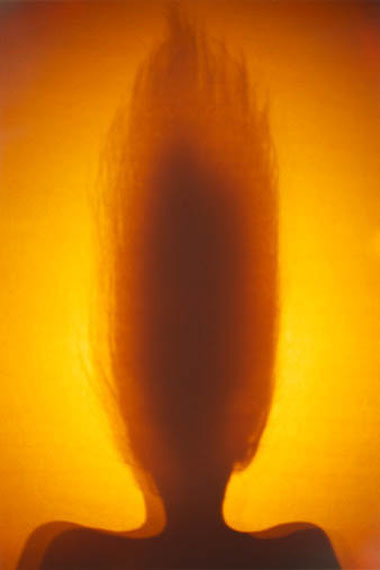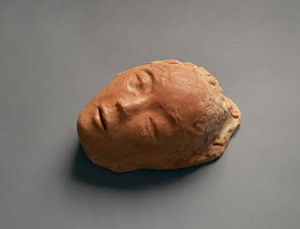
Leiko Ikemura »
Flame & Fire
Exhibition: 29 Oct 2011 – 3 Feb 2012
Fri 28 Oct 18:00

Galerie Priska Pasquer
Konrad-Adenauer-Ufer 83
50668 Köln
+49 (0)221-9526313
Leiko Ikemura "Flame & Fire"
Vernissage: Friday, October 28, 6pm-9pm
Exhibition: Oct 29, 2011 - Feb 2, 2012
Galerie Priska Pasquer is delighted to be presenting an exhibition of the work of Japanese artist Leiko Ikemura. The title of the exhibition, "Flame & Fire", refers to both the sculptural production process as well as the content of the photo series, "sh-h", featured in the exhibition.
The 2011 terracotta sculpture "head-r" shows the face of a young woman. The depiction of the female form is one of the artist's central themes. It is present in many aspects of her paintings, drawings, sculptures and photographs, yet Leiko Ikemura refrains from depicting any specific individual; the images are frequently of sleeping, resting, dreaming figures in a state between activity and passivity.
This suspended state of being and the special atmosphere of the overall oeuvre is, among other things, an expression of the meeting of two cultures. The work of Leiko Ikemura is borne of the meeting of Asian aesthetics and Western culture. Her pieces reference fundamental differences in the perception of reality in the Asian tradition, the lack of separation between figure and space, subject and object.
Particularly in paintings, the artist frequently portrays her figures in silhouettes as "a porous, permeable bodies that open into the surrounding areas" (Pia Müller-Tamm). A sense of loneliness and alienation is present in many of her figures, as well as a feeling of weightlessness.
Leiko Ikemura affords another point of access to her figures with the materiality of her terracotta sculpture "head-r". With its emotively modelled surface, the face conveys individual emotions that can be read as expressions of vulnerability and defenselessness. Yet her sculptures also yield an impression of a suspended and open state of being.
Photography has been an independent part of the artist's oeuvre since the early 1980s. The medium provides Leiko Ikemura with the opportunity to vary a theme within a series and articulate it in different forms while also experimenting with the interplay of light and shadow.
"Flame" and "fire" in the exhibition's title refer both to the firing process involved in terracotta sculpture as well as the "sh-h" series of colour photographs from 1992. The series shows silhouettes, bathed in red light, of the heads of women with long hair photographed upside down. In the prints, the physiognomy of the subjects is reduced to the extreme. The heads appear as abstract ambiguous apparitions; we see them as a co-mingling of light and shadow, movement and rest, all the while holding something akin to a candle's flame.
Brief summary
Leiko Ikemura, born in the small city of Tsu in Japan, left Japan in 1972 to move to Spain. Studied painting in Seville 1973-78. Relocated to Switzerland. First exhibitions, including the Bonner Kunstverein. 1983 "resident graphic artist" in Nuremberg. 1985 moved to Cologne. Since 1991, she has been a professor of painting at Berlin University of the Arts. The artist lives and works in Cologne and Berlin.
The artist's works have been widely shown in Germany and abroad. Currently a comprehensive retrospective of her work is being shown in Japan, first at the National Museum of Modern Art, Tokyo and afterwards at the Mie Prefectural Art Museum, Mie.
Other solo exhibitions include Musée cantonal des Beaux-Arts, Lausanne, 2001; Kunstmuseum Liechtenstein, Vaduz, 2002; Erzbischöfliches Diözesanmuseum Kolumba, Cologne, 2006; Vangi Sculpture Garden Museum, Shizuoka, 2006; Langen Foundation, Neuss, 2007; 2009 August-Macke-Award from the City of Arnsberg.
Die Galerie Priska Pasquer freut sich eine Ausstellung der japanischen Künstlerin Leiko Ikemura zu präsentieren. Der Titel der Ausstellung „Flame & Fire“ bezieht sich auf den Produktionsprozess der ausgestellten Skulptur "head-r" als auch auf den Inhalt der in der Ausstellung gezeigt fotografischen Serie „sh-h“.
Die Terrakottaskulptur „head-r“ von 2011 zeigt das Gesicht einer jüngeren Frau. Die Darstellung von weiblichen Wesen ist das zentrale Thema der Künstlerin. Diese finden sich in vielfältigen Formen ihrer Malerei, Zeichnung, Skulptur und Fotografie. Dabei verzichtet Leiko Ikemura auf die Darstellung eines bestimmten Individuums - oft sind es schlafende, ruhende, träumende Figuren in einem Zustand zwischen Aktivität und Passivität.
Dieser schwebende Zustand und die spezielle Atmosphäre des gesamten Oeuvres ist unter anderem Ausdruck der Begegnung zweier Kulturen. Das Werk von Leiko Ikemura entsteht in der Begegnung von asiatischer Ästhetik und westlicher Kultur. Ihre Arbeiten verweisen auf die grundlegend verschiedene Wahrnehmung der Wirklichkeit in der asiatischen Tradition: der Nicht-Trennung zwischen Figur und Raum, Subjekt und Objekt.
In diesem Sinne zeigt die Künstlerin ihre Figuren vor allem in der Malerei meist nur in Umrissen, als “poröse, durchlässige Körper, die sich zum Umraum hin öffnen” (Pia Müller-Tamm). In vielen ihrer Figuren findet sich das Gefühl der Einsamkeit und Fremdheit aber auch der Leichtigkeit.
Über die Materialität der Terrakotta Skulptur "head-r" vermittelt Leiko Ikemura einen anderen Zugang zur ihren Figuren. Das Gesicht zeigt mit seiner bewegt modellierten Oberfläche individuelle Emotionen, die als Ausdruck von Verletzlichkeit und Schutzlosigkeit gelesen werden können. Aber auch in ihren Skulpturen findet sich der Eindruck eines schwebenden und offenen Zustandes. 
Die Fotografie ist seit Beginn der 1980er Jahre ein eigenständiger Bestandteil im Oeuvre der Künstlerin. Das Medium bietet Leiko Ikemura die Möglichkeit ein Motiv im Rahmen einer Serie zu variieren und in verschiedenen Formen durchzuspielen. Besonders ermöglicht die Fotografie der Künstlerin mit dem Thema Licht und Schatten zu experimentieren.
‚Flamme’ und ‚Feuer’ im Titel der Ausstellung verweisen sowohl auf den Brennprozess bei der Produktion der Terrakottaskulptur als auch auf die Serie "sh-h" von Farbfotografien aus dem Jahr 1992. Die Serie zeigt schemenhafte, in ein rotes Licht getauchte, Schattenrisse eines kopfüber fotografierten Frauenkopfes mit langen Haaren. In den Aufnahmen wird das Physiognomische der fotografierten Personen auf das äußerste reduziert. Die Köpfe erscheinen als abstrakte doppeldeutige Formen; wir sehen sie als ein Spiel von Licht und Schatten, Bewegung und Ruhe - und zugleich lassen sie sich als die Flammen einer Kerze lesen.
Kurzinformation
Leiko Ikemura, in der Kleinstadt Tsu in Japan geboren, verlässt 1972 Japan nach Spanien. Studium der Malerei in Sevilla 1973-78. Übersiedlung in die Schweiz. Erste Ausstellungen unter anderem im Bonner Kunstverein. 1983 ‚Stadtzeichnerin’ in Nürnberg. 1985 Wechsel nach Köln. Seit 1991 Professorin für Malerei an der Universität der Künste, Berlin. Die Künstlerin lebt und arbeitet in Köln und Berlin.
Die Arbeiten von Leiko Ikemura sind vielfach im In- und Ausland augestellt worden. Derzeit wird in Japan eine umfangreiche Retrospektive der Künstlerin gezeigt. Im Anschluss an das National Museum of Modern Art, Tokyo, ist die Retrospektive derzeit im Mie Prefectural Art Museum, Mie, zu sehen.
Weitere Einzelausstellungen unter anderem im Musée cantonal des Beaux-Arts, Lausanne, 2001; Kunstmuseum Liechtenstein, Vaduz, 2002; Erzbischöfliches Diözesanmuseum Kolumba, Köln, 2006; Vangi Sculpture Garden Museum, Shizuoka, 2006; Langen Foundation, Neuss, 2007. „August-Macke-Preis“ der Stadt Arnsberg, 2009.